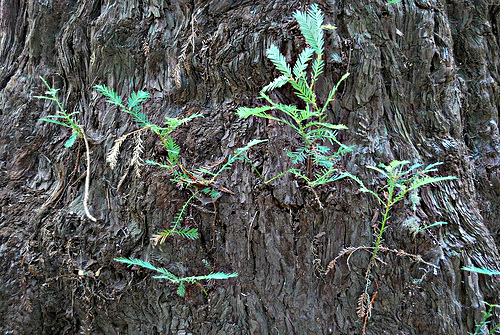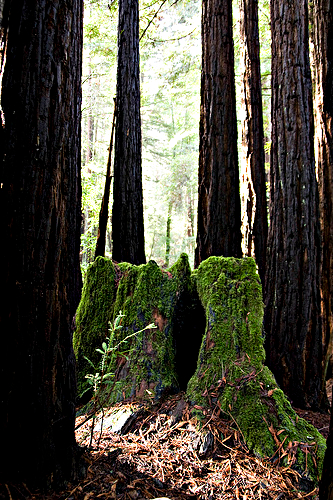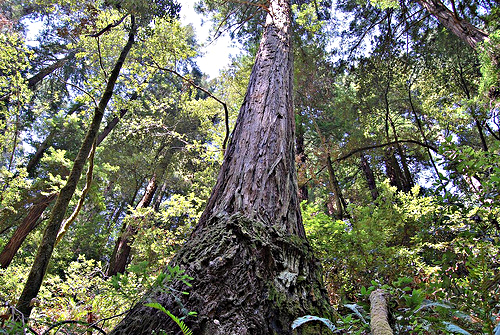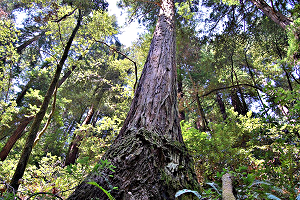New redwood trees can come about in four ways: through seeds, cuttings, stump sprouts, and root sprouts.
Like all plants, redwoods can grow from seeds. Redwood seeds come from those tiny, inch-long redwood cones that fall from the branches in autumn. Each cone contains one to two dozen tiny seeds. These seeds were fertilized with redwood pollen; they are mix of genetic material from the parent that made the seed and the parent that made the pollen. However, redwood seeds have a notoriously low germination rate. Hardly any of them will grow into a plant. Which brings us to the next method of redwood tree generation: cuttings.
Redwood trees that you buy from a nursery probably began as cuttings—branches that were cut from a tree. To make a good redwood cutting, horticulturists will cut a branch from a young tree, or sapling, because cuttings from young trees tend to survive better. They treat the cutting with hormones to encourage growth, and plant the cutting in a special blend of soils. After a few months, about 25-35% of the cuttings have formed roots; the others do not survive. Once the cuttings have established, they can grow quite quickly—up to 7 feet in height in a single growing season. Regeneration from existing branches doesn’t just happen in the nursery—it happens in nature too. When a branch falls off a redwood tree, say in a storm, the branch can come in contact with the soil and develop roots. These provide the branch with nutrients and water, and before long the branch has grown into a tree. Trees grown from cuttings or from branches are genetically identical of the tree that donated the branch. (For the same reason, California’s vineyards are very low in genetic diversity; see this article in the New York Times.)

Stump sprouts on a coast redwood. Photo: kqedquest.
Many a majestic redwood tree began as a stump sprout. Stump sprouts are tiny growths from the base of existing trees. They can grow out of a healthy tree, or a tree that has been logged or damaged by fire. Redwoods have extensive underground root systems, which are impervious to trifling things like lumberjacks’ axes and fire. Trees that grow from stumps grow quickly and have a good chance of success, because the trees are automatically connected to a large root system. Multiple stump sprouts from a single trunk form what is called a fairy ring: a ring of trees, with a circular clearing in the middle, because the original tree breaks down. Stump sprouts are generally genetic clones of the original tree. However, the albino redwoods are stump sprouts with a mutation (or two, or three…). The genomic research happening Stanford will hopefully shed some light on how this mutation happens.

A fairy ring. The ring of trees has sprouted from the moss-covered trunk in the middle. Photo: Swiv.
Redwoods don’t just sprout from stumps; they can also sprout new growth from their roots. Redwood roots extend horizontally under the soil. Many redwoods live in flood-prone ecosystems, on the banks of rivers. When redwood forests become flooded, sediment piles up on the surface of the soil, burying the roots a bit deeper than they were before. Redwoods will grow another set of horizontal roots, a little closer to the surface. By digging deep into the ground and counting the horizontal layers of roots, people can tell how many floods a redwood has endured. When new growth sprouts from the surface roots, the original tree soon has a neighbor that is basically an identical twin. This is what Chris thinks is going on with the three albino redwoods, all in a row.
Hopefully Chris can test his hypothesis in a year or two, when the redwood genome is sequenced and we know what mutation (or mutations) cause albinism. Are the three neighboring albino redwoods mutants that sprung from genetically identical trees? Maybe that tree’s genotype is just a little different from that of an albino—and the mutation that causes albinism is very likely to occur. Or maybe the three albinos are a series of chlorophyll-free coincidences. We’ll have to wait patiently for the genome data. But, for a coast redwood that can live for 2,000 years, the wait won’t be long at all.
37.040928 -122.065315



